

KNOTS
By: Daisy
A few weeks ago, there was a posting about knot tying yet no one posted how to actually tie knots. The kids and I a few years ago came across a game on knot tying. The game awarded points on the proper tying of various knots and their purposes. So, I decided someone else may benefit from the game the kids and I had fun with. I have only included the more functional knots that may be needed. There are about another thirty in the game that are very elaborate and more nautical in use.
| KNOT BASICS | |||
| Parts Of A Rope | |||
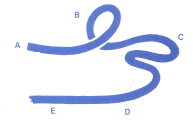 |
|||
|
A. Working End - Used to tie the knots B. Loop C. Bight D. Standing Part E. Standing End |
|
||
|
When you tie a knot, the breaking strength of your line is reduced. The remaining strength is shown below: |
|||
| Beginning Strength Of Line | 100% | ||
| Overhand Knot | 40% | ||
| Timber Hitch | 70% | ||
| Reef Knot | 45% | ||
| Fisherman's Bend | 75% | ||
| Clove Hitch | 75% | ||
| Sheet Bend | 55% | ||
| Bowline | 60% | ||
| Two Half Hitches | 70% | ||
| Blood Knot |
80% |
||
| Rope Storage | |||
| Always coil your rope clockwise. Tie as shown. | |||
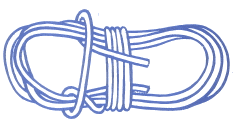 |
|||
 |
|||
| Whipping | |||
| Used to prevent fraying of the ends of rope. It also eliminates the need of end knots when the rope needs to pass through close places. Tied as shown, pull each end of the whipping tightly until it hugs the rope firmly, and then trim the ends | |||
 |
|||
| Seizing | |||
| Used to tie two ropes together as needed or to reinforce a loop that needs additional strength. | |||
| JOINING KNOTS | |||
 |
|||
| Reef Knot | |||
| Tied as shown. Used to tie two ropes together. Use with ropes of equal size only. | |||
 |
|||
| Granny Knot | |||
| This knot is frequently used but will not hold under strain. Note that the working end and the standing part are on opposite sides of the other rope. | |||
 |
|||
| Bowline Bend | |||
| Used when two lines of a different size need tying together. While easy to untie, it is very strong. Tied by joining two bowlines together as shown. |
|||
| HITCHING KNOTS | |||
 |
|||
| Half Hitch | |||
| Tied by passing rope end around an object, then around the standing part in an underhand loop. This knot is the basic knot for temporarily holding rope to an object and is the foundation for many knots. | |||
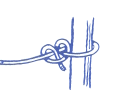 |
|||
| Two Half Hitches | |||
| Tied by passing rope around object and then making two underhand loops around its standing part. This is a basic holding knot used to secure a rope to an object. | |||
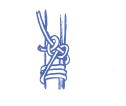 |
|||
| Pipe Hitch | |||
| Tied by taking four or five turns around an object finished with two half hitches. This is a holding knot which will not slide when used for vertical lifting. | |||
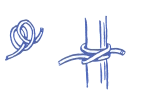 |
|||
| Clove Hitch | |||
| Tied by passing two underhand loops over an object. This is a widely used holding knot which can be tied very rapidly by throwing the loops as when a cowboy ties a calf. | |||
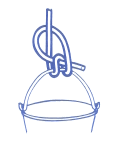 |
|||
| Fisherman's Bend | |||
| Tied as illustrated. Used to tie a line to a bucket or for lifting heavy objects. Holds well and is easy to untie | |||
| BOWLINES AND SEAT KNOTS | |||
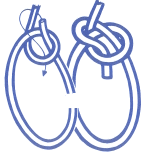 |
|||
| Bowline | |||
| Tied by forming an overhand loop in the standing part of rope, then passing the end through the loop, around the standing part, then back through the loop. This is the basic knot for tying a fixed loop which will not slip or jam. | |||
 |
|||
| French Bowline | |||
| Tied same as bowline with an extra turn passed through the loop before completing the tie. This knot forms a double loop with the proportions of the two loops being adjustable. Used especially as a "Boatswain's Chair" in rescue work. | |||
 |
|||
| Bowline on a Bight | |||
| Tied by taking a long bight, forming an overhand loop, passing the rope through the loop and then passing eye of bight over the fixed loop. This knot forms a double fixed loop | |||
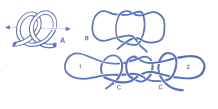 |
|||
| Fireman's Chair | |||
| Form 2 loops (A) to form a handcuff knot (B) used for rescue service. Tighten the knot and place one loop (1) under the knees and loop (2) around the back and under the arms. The half hitches (C) are then fixed to lock each loop in place. Use the standing part of the rope to lift or lower the person while another person pulls the working end for support | |||
| KNOTS FOR FUN | |||
 |
|||
| Sheepshank | |||
| Tied by taking up slack with a double bight, then securing each end of the bights with an underhand loop in the standing parts. This knot us used to shorten a length of rope. (To make a more permanent knot, add a second underhand loop to secure each end of the knot.) | |||
 |
|||
| End Loop | |||
| Tied by forming an overhand knot, then proceeding as shown. Pull tight. Used when a loop is needed in boating, climbing, etc. | |||
 |
|||
| Running 8 Knot | |||
| Tied as shown and used to lift or retrieve an object. | |||